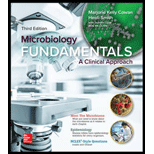
Concept explainers
A single bacterium has _______ epitope(s).
- a. a specific
- b. multiple
- c. MHC
- d. clonal
Introduction:
The capacity of a lymphocyte to distinguish the difference between molecular shapes is so sensitive that it can recognize and respond to only a specific portion of an antigenic molecule. This fragment of the molecule is known as an epitope.
Answer to Problem 1Q
Correct answer:
A single bacterium has multiple epitopes. Therefore, option (b) is correct.
Option (b) is given as “multiple”.
Explanation of Solution
Justify the reason for the correct statement:
The epitope is an antigenic determinant fragment of an antigenic molecule. This is recognized by the immune system. It is the specific portion of antigen molecules and a single antigenic molecule carries multiple epitopes. Paratope is the portion of an antibody that binds to the antigenic epitope and trigger an immune response such as phagocytosis.
Hence, option (b) is correct.
Justify the reasons for the incorrect statements:
Option (a) is given as “a specific”.
Many epitopes are present on antigen molecules that generate specific immunity. Hence, it is a wrong answer.
Option (c) is given as “MHC”.
MHC stands for “major histocompatibility complex”. It is a surface marker that helps presentation of the pathogenic epitope to the T-cells. Hence, it is a wrong answer.
Option (d) is given as “clonal”.
Foreign antigen activates B or T cells that are appropriate (correct) for it by the mechanism of clonal selection. Hence, it is a wrong answer.
Hence, options (a), (c), and (d) are incorrect.
Multiple epitopes are found on a single bacterium.
Want to see more full solutions like this?
Chapter 13 Solutions
Microbiology Fundamentals: A Clinical Approach
- please fill in the empty sports, thank you!arrow_forwardIn one paragraph show how atoms and they're structure are related to the structure of dna and proteins. Talk about what atoms are. what they're made of, why chemical bonding is important to DNA?arrow_forwardWhat are the structure and properties of atoms and chemical bonds (especially how they relate to DNA and proteins).arrow_forward
- The Sentinel Cell: Nature’s Answer to Cancer?arrow_forwardMolecular Biology Question You are working to characterize a novel protein in mice. Analysis shows that high levels of the primary transcript that codes for this protein are found in tissue from the brain, muscle, liver, and pancreas. However, an antibody that recognizes the C-terminal portion of the protein indicates that the protein is present in brain, muscle, and liver, but not in the pancreas. What is the most likely explanation for this result?arrow_forwardMolecular Biology Explain/discuss how “slow stop” and “quick/fast stop” mutants wereused to identify different protein involved in DNA replication in E. coli.arrow_forward
- Molecular Biology Question A gene that codes for a protein was removed from a eukaryotic cell and inserted into a prokaryotic cell. Although the gene was successfully transcribed and translated, it produced a different protein than it produced in the eukaryotic cell. What is the most likely explanation?arrow_forwardMolecular Biology LIST three characteristics of origins of replicationarrow_forwardMolecular Biology Question Please help. Thank you For E coli DNA polymerase III, give the structure and function of the b-clamp sub-complex. Describe how the structure of this sub-complex is important for it’s function.arrow_forward
 Medical Terminology for Health Professions, Spira...Health & NutritionISBN:9781305634350Author:Ann Ehrlich, Carol L. Schroeder, Laura Ehrlich, Katrina A. SchroederPublisher:Cengage Learning
Medical Terminology for Health Professions, Spira...Health & NutritionISBN:9781305634350Author:Ann Ehrlich, Carol L. Schroeder, Laura Ehrlich, Katrina A. SchroederPublisher:Cengage Learning
 Concepts of BiologyBiologyISBN:9781938168116Author:Samantha Fowler, Rebecca Roush, James WisePublisher:OpenStax College
Concepts of BiologyBiologyISBN:9781938168116Author:Samantha Fowler, Rebecca Roush, James WisePublisher:OpenStax College





